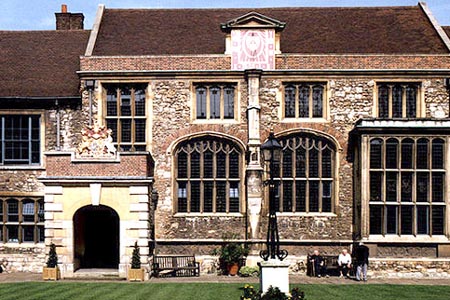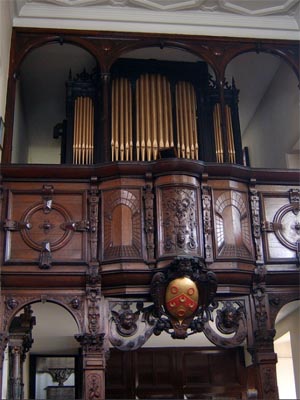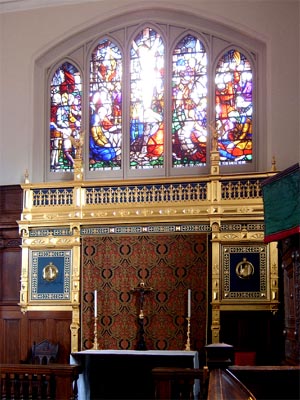| |
 |
 |
 |
| Comment on this report, or find other reports. |
 |
| Our Mystery Worshippers are volunteers who warm church pews for us around the world. If you'd like to become a Mystery Worshipper, start here. |
 |
| Find out how to reproduce this report in your church magazine or website. |
|
|
| 3110: Chapel of Sutton's Hospital, Charterhouse, London |
 |
 |
 |
Mystery Worshipper: Cool Dude.
The church: Chapel of Sutton's Hospital, Charterhouse, London.
Denomination: Church of England. Charterhouse is a Peculiar, which means (quoting from their website) "that it’s overseen by an ordinary (the Master), rather than the bishop. In practice, the chapel priest (the Preacher) is appointed in consultation with London Diocese, and is licensed by the Bishop of London."
The building: Charterhouse is a complex of buildings that date back to the 14th century, when the Carthusian Monastery of the Salutation of the Virgin Mary was built on the site of a graveyard for victims of the Plague. In fact, "Charterhouse" is an Anglicisation of Grande Chartreuse, the fatherhouse of the Carthusian order near Grenoble, France, where to this day the monks prepare the secret mixture of herbs and spices that go to make up Chartreuse liquor. With the dissolution of the monasteries in 1537, the monks' cells saw a variety of uses. The merchant adventurer Thomas Sutton acquired the property in 1611 and bequeathed it in his will as a hospital (almshouse) for "soldiers that have borne arms by sea or land, merchants decayed by piracy or shipwreck, or servants in household to the King or Queens Majesty" and a school. Rebuilt and enlarged around that time, Charterhouse has the appearance of a rambling 16th century mansion. Badly damaged in World War II, it was again restored. The chapel dates from 1613, though like the rest of Charterhouse, it has the look of a repeatedly altered building. The two aisles are of almost equal width, one dominated by Thomas Suttons elaborate tomb and the other by an ancient communion table that looks as old as the building, supported on a forest of columns. There is a handsome classical arcade marching down the middle of the Tudor-looking building, adding to the sense of layered history though the columns somewhat hamper sightlines (as I was pleasantly to find out read on!). The school was relocated to the market town of Goldaming in 1872, and its buildings were eventually occupied by St Bartholomew's Hospital, now Barts and The London School of Medicine and Dentistry (or Barts and The London for short).
The church: The Carthusian monks resisted the suppression of the monasteries, resulting in the prior being hanged, drawn and quartered, and nine of his brothers in Christ being imprisoned and starved to death. Today their memorial can be found near Barts and The London. The hospital that Thomas Sutton established remains to this day, with the Brothers (as its residents are called) now sharing space with a number of elderly women residents as well as private and commercial tenants. Also on the grounds is the Queen Elizabeth II Infirmary, providing skilled nursing and end-of-life hospice care. Services in the chapel include weekday morning and evening prayer and Sunday eucharist, and are open to all. Quoting from their website, "The gatekeeper will be happy to admit anyone who would like to attend." (But again, read on!)
The neighbourhood: The Charterhouse sits at the back of Charterhouse Square, a grassy garden that is undergoing extensive landscaping. This is just on the fringe of the City, the financial district. The kids staggering home from Smithfield nightclubs who used to set the tone of the area are these days fewer, following a 2016 clampdown on licensing and sale of drugs. The discretely fancy hotel right next door to the Charterhouse seems to be quiet, presumably catering to corporate weekday clients rather than tourists.
The cast: The Revd Robin Isherwood, Preacher (i.e., the chapel priest) and Deputy Master of Charterhouse.
The date & time: Sunday, 5 February 2017, 9.45am.
What was the name of the service?
Eucharist.
How full was the building?
About 30 in a chapel that would were you to fill all the nooks and crannies seat five times that number.
Did anyone welcome you personally?
The Preacher recognised me as a non-regular and gave me a warm welcome. He was dressed in a white habit in the Carthusian tradition but the loose weave white cloth gave it the slightly comic appearance of an Edwardian nightshirt. (He wisely later put on vestments.)
Was your pew comfortable?
Some of the pews are sideways facing, college chapel style, whilst elsewhere they face forward. Upholstered chairs bearing the Charterhouse crest fill yet other spaces. I made a bad choice a pew that was not at all the right shape for my back.
How would you describe the pre-service
atmosphere?
Reverent but informal most people seemed to be Brothers (residents) or their families.
What were the exact opening words of the
service?
The Preacher said, "Good morning, and a warm welcome to our guest." I assumed this meant a Governor of the Charterhouse or some distinguished person. "But I cannot see him!" he added, and stepped a bit to one side where he could spot me! more easily. It seems that I was concealed behind one of those sightline-masking columns. Such a personal welcome is rare, but so appreciated when offered.
What books did the congregation use during the
service?
A service booklet and weekly sheet with the readings. According to their website, their services follow the 17th century language of the Book of Common Prayer, although in practice this seems to mean Common Worship II.
What musical instruments were played?
Organ, a two manual Walker instrument given a major restoration in 2003.

Photo:
© Nicholas Jackson and used under license
Did anything distract you?
The way the pew met my back.
Was the worship stiff-upper-lip, happy clappy, or
what?
A dignified service at a brisk pace for a resident community.
Exactly how long was the sermon?
6 minutes. Chatting afterwards, I learned that Charterhouse sermons are limited to six minutes an ideal length in my view. Is there any hope this rule will be more widely adopted?
On a scale of 1-10, how good was the preacher?
8 – A solid sermon on the meaning of Candlemas.
In a nutshell, what was the sermon
about?
The Bishop of London had observed at his Candlemas service that he saw a London diocese in which the Anglican Church was increasingly Chinese. Candlemas, which we observe on this Sunday, is to do with change and transition. The readings of the day about Simeon in the Temple he who had been able to depart in peace, having seen salvation are not only about death but about readiness. Candlemas brings us not to an end, but rather to a sense of gathering.
Which part of the service was like being in
heaven?
After we had taken communion, the Preacher and his server moved into the body of the chapel to minister the Sacrament to those Brothers who were too immobile to approach the communion rail. One frail gent had sat with head bowed for much of the service, and as the chalice approached him it was clear to those close by that he was not in prayer but fast asleep. The Preacher gently touched his arm, whereupon he awoke without a start and accepted the Sacrament with complete readiness. I found this small Candlemas moment most affecting.

Photo:
© Nicholas Jackson and used under license
And which part was like being in... er... the other place?
As mentioned above, their website states that "The gatekeeper will be happy to admit anyone who would like to attend." But at the Porter's Lodge, which at first sight seems unstaffed and slightly intimidating if you are not used to such things, you need to ring the bell, state you are going to the chapel, and then sign in. The route to the chapel is confusing and unmarked. On leaving, it was not clear how to get out. A Brother gave me directions, but these didnt match the routes available. In fact, one has to exit through a door clearly marked "No Entry." The coming and going are scarcely hellish – but they aren't welcoming either.
What happened when you hung around after the service looking lost?
I chatted with one or two of those present; it was a friendly atmosphere. I was invited to stay for coffee but couldn't.
How would you describe the after-service
coffee?
I cannot say.
How would you feel about making this church your regular (where 10 = ecstatic, 0 = terminal)?
7 – If it weren't a private chapel I might consider it.
Did the service make you feel glad to be a
Christian?
Yes.
What one thing will you remember about all this in seven days' time?
The moment the sleeping communicant awoke. |
|
|
 |
 |
 |
| We rely on voluntary donations to stay online. If you're a regular visitor to Ship of Fools, please consider supporting us. |
 |
 |
 |
| The Mystery Pilgrim |
 |
| One of our most seasoned reporters makes the Camino pilgrimage to Santiago de Compostela in Spain. Read here. |
 |
 |
 |
| London churches |
 |
| Read reports from 70 London churches, visited by a small army of Mystery Worshippers on one single Sunday. Read here. |
| |
|
|
|
|


